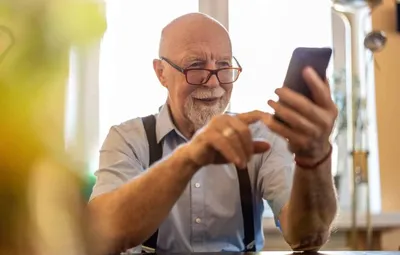Keeping Care Homes Connected With Perfect Mobile Signal
How to guarantee smoother communication for every resident and reliable, efficient processes for your staff
In the last decade, smartphones have completely changed the way society functions. We work differently, we watch TV differently, we shop differently and pay for things differently too.
Fast-forward to the start of the ‘20s and they’re suddenly a necessity.
Did you know that telecoms was declared a critical sector during the heights of the COVID-19 pandemic? Its role in servicing the population was put on a par with healthcare and emergency services.
Sure it sounds a little odd at first hearing – we’ve never heard of any smart phone performing CPR either – but when you consider the jeopardy that the nation’s mental health has been in during the last year, it begins to make more sense.
Sadly, the pandemic’s put enormous physical distance between elderly people in care homes and their families, and it’s only very recently that social distanced visiting has opened up a little more, still with tight regulations and strict limits on numbers.
Which is why mobile phones continue to play such a crucial role in care homes across the country.
Amazing acts of kindness to provide the elderly with smartphones
The nation’s cottoned onto the need for mobile devices – including for the most elderly among us – and they’ve proved an amazing means for communication during lockdowns.
But still, not all care home residents own a mobile phone themselves.
Amazingly, several commercial organisations responded to the pandemic and the ensuing isolation problem by donating surplus devices to the elderly in hospitals and care homes across the UK.
Those care home residents fortunate enough to receive one have been able to use simple communication functions to stay in touch with loved ones as best they could under the circumstances.
Smart phones have become a major enabler for communication, supporting mental health and reducing anxiety through these rough times – in the old as well as the young.

Care home staff becoming more reliant on smartphones too
And it’s not just the residents who’ve benefited so greatly from smartphones over the last year either.
Regardless of the pandemic, healthcare staff and carers have become more and more reliant on smartphones during the last few years, for patient monitoring and other routine processes.
As you’ll well know, mobile devices are ideal for taking notes, making observations, recording medication intake and a host of other typical tasks of a care home worker.
Being able to centrally store all this information in one easily accessible place saves heaps of time and hassle for carers too, and reduces the risk of mixed messages or loss of information typical of pen and paper processes.
It doesn’t take a genius to work out that reliable mobile connectivity is at the heart of all this.
But the pandemic’s highlighted a serious problem with the infrastructure that should underpin these daily operations and enable better communication.
How to close the gaps in infrastructure
Now that the need for smartphones and faster, contactless processes has been sped up so unceremoniously, unreliable mobile connectivity in care homes is becoming a bigger and more serious problem.
What’s more, the UK is expected to replace is legacy TETRA public safety communications network with 4G in the next two years. It means that emergency services will be able to leverage digital apps like live video feeds and wearable tech.
Organisations without reliable 4G will be left behind.
In care homes, that means staff won’t be able to raise the alarm effectively and first response teams wouldn’t be able to effectively manage an emergency situation.
It’s great that so many care homes and residents have embraced smart technology, particularly in the last year. But without reliable mobile signal? It’s all pretty fruitless.
Sure, Wi-Fi might be available, but if residents are forced to self-isolate in their own rooms, many of which don’t have Wi-Fi access, they suddenly become cut off from society. And unfortunately, modern building layouts and materials (like galvanised steels and tinted glass) mean that plenty of structures feature a plethora of not-spots.
How to deliver safe, consistent communication in care homes
Ensuring that Wi-Fi problems and not-spots don’t get in the way of providing great care and enabling communication is as simple as bringing the outdoor signal indoors.
With a mobile signal booster, like the ones we provide at Signal Solutions, it’s super easy to do this – with no long timescales and no worries about legalities.
We exclusively use Nextivity Cel-Fi technology which means we can guarantee your care home a 100% legal solution to the mobile signal problem.
Our boosters are unconditionally network safe, accepted by the UK regulators and compatible with every mobile network.
If you’d like to provide high quality, reliable mobile coverage in your care home using affordable and unobtrusive equipment that meet all of Ofcom’s many stipulations? Let’s have a chat.
Give us a call on 020 3823 7365 if you’d like to establish reliable mobile signal, improve your monitoring processes and enable better communication between your residents and their loved ones.